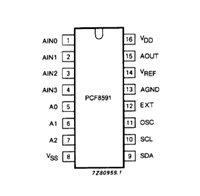ATF16V8B
Macrocell Configuration
Software compilers support the three different OMC
modes as different device types. Most compilers have the
ability to automatically select the device type, generally
based on the register usage and output enable (OE) us-
age. Register usage on the device forces the software to
choose the registered mode. All combinatorial outputs
with OE controlled by the product term will force the soft-
ware to choose the complex mode. The software will
choose the simple mode only when all outputs are dedi-
cated combinatorial without OE control. The different de-
vice types can be used to override the automatic device
selection by the software. For further details, refer to the
compiler software manuals.
In registered mode pin 1 and pin 11 are permanently con-
figured as clock and output enable, respectively. These
pins cannot be configured as dedicated inputs in the reg-
istered mode.
In complex mode pin 1 and pin 11 become dedicated in-
puts and use the feedback paths of pin 19 and pin 12 re-
spectively. Because of this feedback path usage, pin 19
and pin 12 do not have the feedback option in this mode.
In simple mode all feedback paths of the output pins are
routed via the adjacent pins. In doing so, the two inner
most pins (pins 15 and 16) will not have the feedback op-
tion as these pins are always configured as dedicated
combinatorial output.
When using compiler software to configure the device, the
user must pay special attention to the following restrictions
in each mode.
ATF16V8B Registered Mode
PAL Device Emulation / PAL Replacement
sum term. When the macrocell is configured as an input,
the output enable is permanently disabled.
The registered mode is used if one or more registers are
required. Each macrocell can be configured as either a
registered or combinatorial output or I/O, or as an input.
For a registered output or I/O, the output is enabled by the
OE pin, and the register is clocked by the CLK pin. Eight
product terms are allocated to the sum term. For a combi-
natorial output or I/O, the output enable is controlled by a
product term, and seven product terms are allocated to the
Any register usage will make the compiler select this
mode. The following registered devices can be emulated
using this mode:
16R8 16RP8
16R6 16RP6
16R4 16RP4
Combinatorial Configuration for
Registered Mode (1, 2)
Registered Configuration
for Registered Mode(1, 2)
Notes:
Notes:
1. Pin 1 and Pin 11 are permanently configured as CLK and
OE.
2. The development software configures all the architecture
control bits and checks for proper pin usage automatically.
1. Pin 1 controls common CLK for the registered outputs.
Pin 11 controls common OE for the registered outputs.
Pin 1 and Pin 11 are permanently configured as CLK and OE.
2. The development software configures all the architecture
control bits and checks for proper pin usage automatically.
1-13






 STM32F030C6芯片介绍:主要参数分析、引脚配置说明、功耗及封装
STM32F030C6芯片介绍:主要参数分析、引脚配置说明、功耗及封装

 PCF8591数据手册解读:参数、引脚说明
PCF8591数据手册解读:参数、引脚说明

 一文带你了解ss8050参数、引脚配置、应用指南
一文带你了解ss8050参数、引脚配置、应用指南

 深入解析AD7606高性能多通道模数转换器:资料手册参数分析
深入解析AD7606高性能多通道模数转换器:资料手册参数分析
